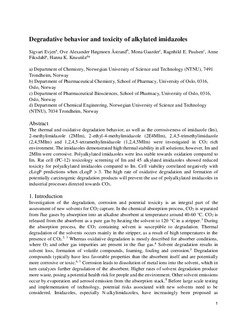| dc.contributor.author | Evjen, Sigvart | |
| dc.contributor.author | Åstrand, Ove Alexander Høgmoen | |
| dc.contributor.author | Gaarder, Mona | |
| dc.contributor.author | Paulsen, Ragnhild Elisabeth | |
| dc.contributor.author | Fiksdahl, Anne | |
| dc.contributor.author | Knuutila, Hanna K | |
| dc.date.accessioned | 2020-01-21T14:15:59Z | |
| dc.date.available | 2020-01-21T14:15:59Z | |
| dc.date.created | 2019-12-20T11:33:50Z | |
| dc.date.issued | 2020 | |
| dc.identifier.issn | 0888-5885 | |
| dc.identifier.uri | http://hdl.handle.net/11250/2637292 | |
| dc.description.abstract | The thermal and oxidative degradation behavior and the corrosiveness of imidazole (Im), 2-methylimidazole (2MIm), 2-ethyl-4-methylimidazole (2E4MIm), 2,4,5-trimethylimidazole (2,4,5MIm), and 1,2,4,5-tetramethylimidazole (1,2,4,5MIm) were investigated in a CO2 rich environment. The imidazoles demonstrated high thermal stability in all solutions; however, Im and 2MIm were corrosive. Polyalkylated imidazoles were less stable toward oxidation compared to Im. Rat cell (PC-12) toxicology screening of Im and 45 alkylated imidazoles showed reduced toxicity for polyalkylated imidazoles compared to Im. Cell viability correlated negatively with cLogP predictions when cLogP > 3. The high rate of oxidative degradation and formation of potentially carcinogenic degradation products will prevent the use of polyalkylated imidazoles in industrial processes directed toward CO2. | nb_NO |
| dc.language.iso | eng | nb_NO |
| dc.publisher | American Chemical Society | nb_NO |
| dc.title | Degradative behavior and toxicity of alkylated imidazoles | nb_NO |
| dc.type | Journal article | nb_NO |
| dc.type | Peer reviewed | nb_NO |
| dc.description.version | acceptedVersion | nb_NO |
| dc.source.journal | Industrial & Engineering Chemistry Research | nb_NO |
| dc.identifier.doi | 10.1021/acs.iecr.9b05100 | |
| dc.identifier.cristin | 1763274 | |
| dc.relation.project | Norges forskningsråd: 233776 | nb_NO |
| dc.description.localcode | Locked until 18.12.2020 due to copyright restrictions. This document is the Accepted Manuscript version of a Published Work that appeared in final form in [Industrial & Engineering Chemistry Research], copyright © American Chemical Society after peer review and technical editing by the publisher. To access the final edited and published work see https://doi.org/10.1021/acs.iecr.9b05100 | nb_NO |
| cristin.unitcode | 194,66,25,0 | |
| cristin.unitcode | 194,66,30,0 | |
| cristin.unitname | Institutt for kjemi | |
| cristin.unitname | Institutt for kjemisk prosessteknologi | |
| cristin.ispublished | false | |
| cristin.fulltext | postprint | |
| cristin.qualitycode | 2 | |
